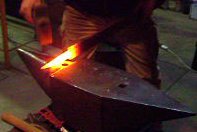Steel Tempering Colors
The tempering process of hardening steel.
Steels containing more than 0.3% carbon are intended for heat treatment. Lower values of carbon makes the steel more tough than hard and suitable for applications where strength are important - like springs and high tensile bolts. Steels with carbon content in excess of 0.7% can be hardened to a higher degree and are suitable for applications where hardness rather than toughness is important. Tool steels make excellent cutting and drilling equipment as they contain tungsten, molybdenum, cobalt, and vanadium to increase heat resistance and durability.

Tempering steel is a two-step process where the
1. The tool is forged and hardened
- tool end is heated to bright red color and forged
| Temperature | Color of Heated Carbon Steel | |
|---|---|---|
| (oF) | (oC) | |
| 2192 | 1200 | |
| 2012 | 1100 | |
| 1922 | 1050 | |
| 1796 | 980 | |
| 1706 | 930 | |
| 1598 | 870 | |
| 1490 | 810 | |
| 1400 | 760 | |
| 1292 | 700 | |
| 1202 | 650 | |
| 1112 | 600 | |
- tool quenched in cold water and cooled until touchable
- tool is sharpened and polished
2. The tool is tempered
- tool heated to tempering temperature as indicated below
| Temperature | Color of Heated Carbon Steel | ||
|---|---|---|---|
| (oF) | (oC) | ||
| 600 | 316 | Scrapers, spokeshaves | |
| 560 | 293 | Screwdrivers, springs, gears | |
| 540 | 282 | Cold chisels, center punches | |
| 520 | 271 | Taps <= 1/4 inch | |
| 500 | 260 | Axes, wood chisels, drifts, taps >= 1/ inch, nut taps, thread dies, press tools | |
| 480 | 249 | Twist drills, large taps, knurls | |
| 460 | 238 | Dies, punches, bits, reamers | |
| 450 | 232 | Twist drills for hard use | |
| 440 | 227 | Turning tools, lathe tools, scrapers, milling, cutters, reamers | |
| 430 | 221 | Edge tools, reamers | |
| 420 | 216 | Knives, hammers | |
- tool quenched in cold water
Note that oil baths and salt bats are also used extensively for tempering steel tools. Lead baths and sand baths are also used.
If steel is heated in an oxidizing atmosphere - like air - a film of oxide forms on the surface and the color changes as the temperature increases. The colors are affected to some extent by the composition of the steel and the method may not be dependable.
Melting Points of Heat-Treating Baths
| Material | Melting Point | |
|---|---|---|
| (oF) | (oC) | |
| 35% lead, 65% tin | 358 | 181 |
| 50% sodium nitrate, 50% porassium nitrate | 424 | 218 |
| Tin | 450 | 232 |
| Sodium nitrate | 586 | 308 |
| Lead | 620 | 327 |
| Potassium nitrate | 642 | 339 |
| 45% sodium chloride, 50% sodium sulfate | 1154 | 623 |
| Sodium chloride | 1474 | 801 |
| Sodium sulfate | 1618 | 881 |
| Barium chloride | 1760 | 960 |
Related Topics
-
Material Properties
Properties of gases, fluids and solids. Densities, specific heats, viscosities and more. -
Miscellaneous
Engineering related topics like Beaufort Wind Scale, CE-marking, drawing standards and more.
Related Documents
-
Brinell Hardness Number - BHN
The Brinell hardness test of metals and alloys. -
Carbon and Low-Alloy Steel Classifications
Steel is considered to be carbon steel when no minimum content is specified or required for chromium, cobalt, columbium (niobium), molybdenum, nickel, titanium, tungsten, vanadium or zirconium. -
Color Mixing Theory
Subtractive and additive color mixing. -
Metals and Alloys - Melting Temperatures
The melting temperatures for some common metals and alloys. -
Stainless Steel Classifications
Stainless steels are commonly grouped into martensitic stainless steels, ferritic stainless steels, austenitic stainless steels, duplex (ferritic-austenitic) stainless steels, and precipitation-hardening stainless steels. -
Stainless Steels - Identification Tests
Magnetic, spark, hardness and acid identification tests for austenitic, martensitic and ferritic stainless steels. -
Steels - Endurance Limits and Fatigue Stress
Endurance limits and fatigue stress for steels. -
Welding Temperatures
Melting and welding temperatures.




